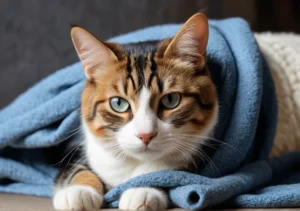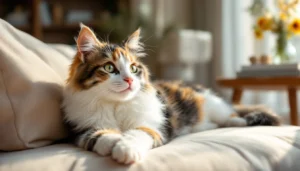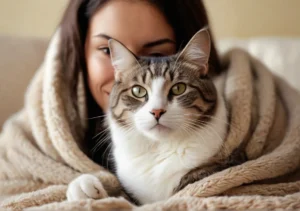Cats are mysterious creatures with a plethora of adorable habits, one of which is kneading soft blankets. But have you ever wondered why cats engage in this behavior? Let’s uncover the reasons behind why cats knead soft blankets in this blog post.
Cats knead soft blankets as a behavior that stems from kittenhood and serves both practical and instinctual purposes. While it may seem like a simple act, there are several reasons why your feline friend kneads those cozy blankets with their paws.
Comfort and Security
Kneading soft blankets is a common behavior in cats that goes beyond just making the fabric more comfortable. This soothing action actually harkens back to their earliest days as kittens, providing a sense of comfort and security reminiscent of their time nursing with their mother. The rhythmic motion of kneading mimics the movement of their paws during feeding, releasing endorphins that help cats feel relaxed and content. So, the next time you see your feline friend happily kneading away on a cozy blanket, remember that they are seeking a familiar and comforting sensation that brings them back to their early days of warmth and safety.
Marking Territory
Cats are territorial creatures, and they have a unique way of marking their space through kneading. By using their scent glands located in the pads of their paws, cats leave behind their scent when they knead a soft surface like a blanket. This action not only marks the territory as their own but also helps them feel more secure in their environment. So, next time you catch your cat kneading their favorite blanket, know that they are not only seeking comfort but also claiming that spot as their own through their unique scent markings.
Additionally, providing your cat with a designated blanket or bed for kneading can help satisfy this natural instinct while keeping your other furniture intact. Remember: happy cat, happy home!
Extra tip: To promote a positive kneading experience, you can gently pet or stroke your cat while they knead, reinforcing the bond between you and providing additional comfort during this soothing activity.
Stress Relief
Kneading soft blankets isn’t just a quirky habit cats have – it actually serves a purpose! Similar to how humans use stress balls or fidget toys, kneading helps cats relieve stress and anxiety. When a cat kneads, it releases endorphins, which are feel-good hormones that help them relax and feel comforted. So next time you see your furry friend engaging in this behavior, know that they’re just trying to destress and unwind in their own unique way.
Instinctual Behavior
Have you ever wondered why cats knead soft blankets? It all goes back to their instincts. When kittens are nursing, they knead their mother’s belly to stimulate milk flow. This behavior becomes ingrained in them, and even as adults, they continue to knead soft surfaces like blankets out of comfort and familiarity. It’s their way of reminiscing about their kittenhood and feeling safe and secure.
Additional Unique Insight:
Did you know that kneading also helps cats mark their territory? Cats have scent glands in their paw pads, so when they knead a blanket, they are leaving behind their scent as a way of claiming that specific spot as their own. It’s like a subtle way of saying, “This is mine!”
Temperature Regulation
Cats knead soft blankets as a way to regulate their body temperature. This behavior can be traced back to their wild ancestors who would knead tall grass or foliage to create a cozy spot to rest. By kneading a soft surface like a blanket, cats are able to create a comfortable and warm space for themselves. This action helps them relax and maintain a comfortable body temperature, especially during colder months. So, the next time you see your feline friend kneading their favorite blanket, remember that they are simply trying to create a warm and cozy spot for themselves.
Maintaining Claws
Kneading also serves an important purpose for cats in maintaining their claws. When cats knead a soft blanket, they are essentially exercising their claws, helping to keep them sharp and healthy. This natural behavior mimics scratching and helps cats keep their claws in optimal condition. Regular kneading on a soft surface like a blanket can prevent their claws from becoming overgrown or dull. So, the next time you see your cat kneading, know that they are not only seeking comfort but also taking care of their claws in the process.
- Extra Tip: Providing your cat with a scratching post can help satisfy their need to knead and keep their claws healthy and trim. Encourage your cat to use the scratching post by placing it near their favorite kneading spot.
Bonding and Affection
When your cat kneads on a soft blanket, it’s not just for comfort; it’s also a way for them to bond with you. This rhythmic motion mimics the kneading they did as kittens while nursing, signaling contentment and love towards their human family. So next time you see your cat kneading, know that it’s their way of showing affection and forming a deeper connection with you.
Interesting Facts About Cat Behavior
Did you know that kneading is also a way for cats to mark their territory? When they knead a soft blanket, they release scent glands in their paws, leaving behind their unique scent. This behavior helps them feel secure and comfortable in their environment. Additionally, cats may knead when they are feeling happy, relaxed, or simply seeking attention from their favorite human.
- Cats may knead soft blankets more often when they are feeling content or when they are in a relaxed state.
- Some cats may also suckle on the blanket while kneading, a behavior reminiscent of nursing from their mothers when they were kittens.
- Providing your cat with a designated blanket or soft towel for kneading can help satisfy their natural instincts and prevent them from kneading on furniture or other items in your home.
- Regular kneading can also help cats stretch and flex their muscles, promoting good circulation and overall well-being.
- If your cat suddenly starts kneading excessively or aggressively, it could be a sign of stress or anxiety. In such cases, it’s best to consult with your veterinarian to address any underlying issues and ensure your cat’s emotional wellness.
By understanding these quirky behaviors and habits of your feline friend, you can strengthen your bond and provide them with the love and care they need to thrive.
Alex, a passionate animal lover, has experience in training and understanding animal behavior. As a proud pet parent to two dogs and three cats, he founded AnimalReport.net to share insights from animal experts and expand his knowledge of the animal kingdom.




